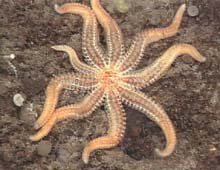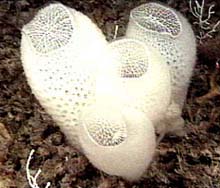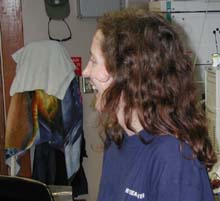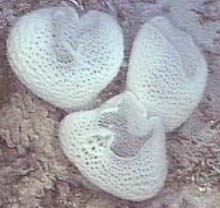Lithoherms Yield New Discoveries
August 27, 2002
Paula Keener-Chavis
National Education Coordinator/Marine Biologist
NOAA Office of Ocean Exploration
![]() Watch a video of snowy groupers, Epinephelus niveatus, supervise the final submersible collections at Site 2. (mp4, 1.5 MB)
Watch a video of snowy groupers, Epinephelus niveatus, supervise the final submersible collections at Site 2. (mp4, 1.5 MB)
It’s always ourselves we find in the sea.
--e.e. cummings
The site that we are currently exploring (aka site 3)consists of a series of Lophelia reefs, or lithoherms (rock pinnacles with living reef on top), in depths of 1,600 to 2,000 feet. A limited number of submersibles dives have been conducted at this site since the mid-60s, and include those made by the Alvin, and one dive by the Johnson-Sea-Link, in the late ‘80s. Dives have also been made here by the U.S. Navy’s submersible NR1, which brought geologists to this region in the ‘90s. Nevertheless, the site which consists of a 400-square mile area approximately 90 miles off Savannah, has never been extensively explored for bioactive compounds or characterized biologically.
Five submersible dives have been conducted over the last two days here and the Johnson-Sea-Link II is presently on its sixth and final dive as this log is being written. “The entire area appears to have numerous pinnacles and ridges oriented in an east-west direction. These structures range in height from 30 to 100 feet and appear to be primarily phosphoritic rock overlain with coarse sand and coral debris,” said John Reed. Sponge collections include hexactinellids and the very beautiful Venus flower basket sponge, complete with a pair of shrimp trapped inside. As the sponge continued to grow, the mesh-like “cap” that gives it its name developed, trapping the unsuspecting pair inside for life. The female shrimp was gravid. Submersible dives in this area have also let Shirley Pomponi get a close up glimpse the largest hexactinellid sponge she has seen in 18 years of research on deep water sponges. And Dive 5 brought us what is expected to be yet another new species of hexactinellid sponge.
Gorgonian corals, many of them small, as well as larger gorgonians and the rare black coral, are also found here. Small sharks, rattails, and scorpaenids make their home here, as do crabs of the genus Geryon and gallatheid crabs. A swordfish swam near the front of the submersible yesterday, this time thankfully without attacking it, as has been witnessed in the past. Many species of sea stars, as well as brittle stars, and sea anemones also live here. “This site has been so productive. We have been getting some great results in the microbial assays and have gotten some really interesting chemical profiles from the samples collected at this site,” said Shirley Pomponi.
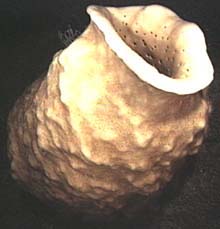
The largest hexactinellid sponge ever seen by Shirley Pomponi in 18 years of research on deep sea sponges. Click image for a larger view.
A blue water dive was also conducted, as divers sought to collect midwater organisms. A blue salp and a cnidarian that produces fluorescent proteins were collected during the dive. According to Tammy Frank, “Tucker trawls of two- to three-hour durations confirm submersible observations that there is not much living in the water column at this site. What we are getting is very small or planktonic, indicating that this is not a very nutrient-rich area.”
The “Eye-in-the-Sea” camera is not working at all now, and computer programs are currently under development for another deployment in October. Despite the fact that images can no longer be obtained from the camera on this Expedition, Dr. Widder is optimistic about what she has learned as part of her explorations with this new technology over the past 10 days.
A message received by the Seward Johnson through NAVTEX reads, “FL-SC-Eastern Sea Coast - Hazardous Exercises to Surface Vessels Will Be Contained In The Following Areas” and the areas listed include the area selected for our final explorations as part of the Islands in the Stream Expedition. Our newly-revised expedition plan is to explore a site located just south of Site 3, an area that has been previously visited by the U.S. Navy’s NR1 submersible.
As the Johnson-Sea-Link II is secured in its cradle, the Seward Johnson will soon be underway to this site. A Tucker trawl, sample processing and identification, video tape review, filming, and writing – with an occasional game of Chess - is what you would see if you were joining us on this nice late summer evening at sea.
Interview with Robin Willoughby, Ph.D., Assistant Scientist
Division of Biomedical Marine Research, HBOI
What is your role during the Expedition?
I am collecting and processing samples for genetic studies on organisms that produce natural products with potential human therapeutic value, primarily sponges. We are interested in growing these organisms in vitro so that we can better understand how and why they produce the natural products. I am bringing back both preserved genetic material and sponge cells that are cryopreserved at -80 degrees. They can be thawed out for further experimentation back at the lab. A lot of my time is spent doing gradient fractionation of sponge cell suspensions to eliminate as much of the unwanted debris and as many of the no sponge contaminants as possible. Forty percent or more of the wet weight of a sponge can be microorganisms, and we want to get the purest sponge sample possible.
How did you get interested in this work?
I have always been interested in biology and living things. To me, that is the ultimate story on this planet. When I moved to Florida and had the opportunity to get closer to the marine environment, it made it that much more interesting. I am a cell and molecular biologist and that gets to the heart of the matter of life. The center of the story of biology is the cell.
What do you like most about this work?
The thrill of discovery. Learning something that has never been known before. Being the first person on the Earth to know something that was previously undiscovered.
What do you find challenging about this work?
The science always makes sense, but the politics are sometimes hard to understand. It is that way with any position. I also find it challenging to be filled with ideas and having to choose only a few of them to pursue. When you work with really great people, you get through all of that.
Sign up for the Ocean Explorer E-mail Update List.















































